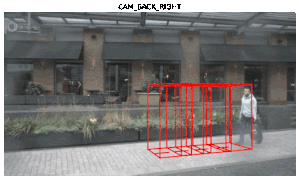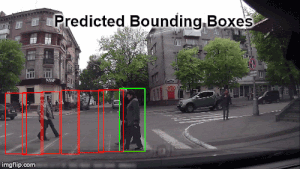Pedestrian 3D Bounding Box Prediction
Saeed Saadatnejad, Yi Zhou Ju,
(published in hEART 2022)

Safety is still the main issue of autonomous driving, and in order to be globally deployed, they need to predict pedestrians’ motions sufficiently in advance. While there is a lot of research on coarse-grained (human center prediction) and fine-grained predictions (human body keypoints prediction), we focus on 3D bounding boxes, which are reasonable estimates of humans without modeling complex motion details for autonomous vehicles. This gives the flexibility to predict in longer horizons in real-world settings. We suggest this new problem and present a simple yet effective model for pedestrians’ 3D bounding box prediction. This method follows an encoder-decoder architecture based on recurrent neural networks, and our experiments show its effectiveness in both the synthetic (JTA) and real-world (NuScenes) datasets. The learned representation has useful information to enhance the performance of other tasks, such as action anticipation.
Please visit the webpage for the paper and the source code.
Pedestrian Intention Prediction: A Multi-task Perspective
Smail Ait Bouhsain*, Saeed Saadatnejad*, Alexandre Alahi
(published in hEART 2020)

In order to be globally deployed, autonomous cars must guarantee the safety of pedestrians. This is the reason why forecasting pedestrians’ intentions sufficiently in advance is one of the most critical and challenging tasks for autonomous vehicles. This work tries to solve this problem by jointly predicting the intention and visual states of pedestrians. In terms of visual states, whereas previous work focused on x-y coordinates, we will also predict the size and indeed the whole bounding box of the pedestrian. The method is a recurrent neural network in a multi-task learning approach. It has one head that predicts the intention of the pedestrian for each one of its future position and another one predicting the visual states of the pedestrian. Experiments on the JAAD dataset show the superiority of the performance of our method compared to previous works for intention prediction. Also, although its simple architecture (more than 2 times faster), the performance of the bounding box prediction is comparable to the ones yielded by much more complex architectures.
Please visit the webpage for the paper and the source code.